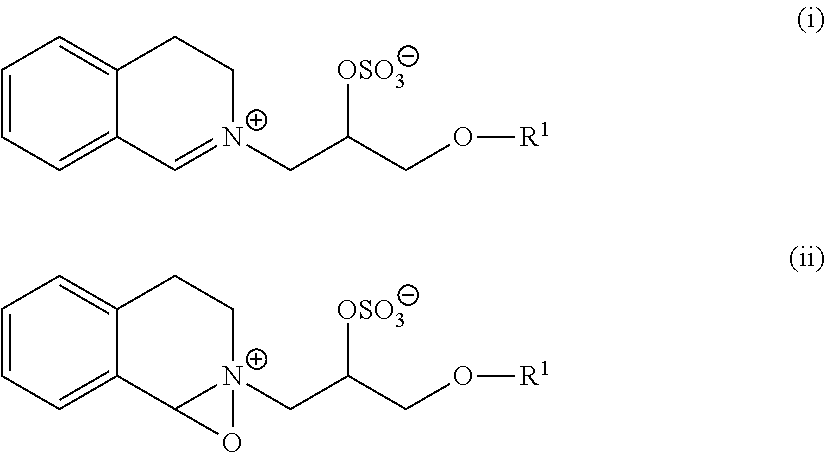Detergent Composition
a detergent composition and composition technology, applied in the field of detergents, can solve the problems of difficult to remove soil by commercially available detergent compositions, bacteria are a source of bad odor, and may remain, so as to improve wash performance, improve wash performance, and increase wash performance
- Summary
- Abstract
- Description
- Claims
- Application Information
AI Technical Summary
Benefits of technology
Problems solved by technology
Method used
Image
Examples
example 1
PCR Amplification
[0640]All PCR amplifications was performed in a volume of 100 microL containing 2.5 units Taq po-lymerase, 100 ng of pSO2, 250 nM of each dNTP, and 10 pmol of each of the two primers described above in a reaction buffer of 50 mM KCl, 10 mM Tris-HCl pH 8.0, 1.5 mM MgCl2.
[0641]Amplification was carried out in a Perkin-Elmer Cetus DNA Termal 480, and consisted of one cycle of 3 minutes at 94° C., followed by 25 cycles of 1 minute at 94° C., 30 seconds at 55° C., and 1 minute at 72° C.
Aspergillus Transformation
[0642]Aspergillus oryzae NBRC4177: available from Institute for fermentation, Osaka; 17-25 Juso, Hammachi 2-Chome Yodogawa-Ku, Osaka, Japan.
[0643]Aspergillus transformation was done as described by Christensen et al.; Biotechnology 1988 6 1419-1422. In short, A. oryzae mycelia were grown in a rich nutrient broth. The mycelia were separated from the broth by filtration. The enzyme preparation Novozyme® (Novozymes) was added to the mycelia in osmotically stabilizing...
example 2
[0645]Construction of the Aspergillus Expression Cassette pJaL1368
[0646]For expression of an A. oryzae gene (SEQ ID NO: 1) encoding a putative nuclease SEQ ID NO: 2) the coding region containing introns (SEQ ID NO: 1) was amplified as a PCR fragment on 931 bp by primer set oJaL316 (SEQ ID NO: 3) and oJaL317 (SEQ ID NO: 4) using A. oryzae NBRC4177 genomic DNA as template. The 931 bp PCR fragment was digested with BamHI and XhoI resulting in a 919 bp fragment (SEQ ID NO: 5). The 919 BamHI-XhoI fragment was cloned into the corresponding sites in pJaL1262, giving plasmid pJaL1368.
example 3
[0647]Expression of Putative A. oryzae Nuclease Gene in Aspergillus Oryzae Strain MT3568
[0648]The Aspergillus expression plasmid pJaL1368 was transformed into the Aspergillus oryzae strains MT3568 as described by Christensen et al.; Biotechnology 1988 6 1419-1422. Twelve randomly selected transformants were purified and inoculated into tubes containing 10 ml YPM medium (2 g / l yeast extract, 2 g / l peptone, and 2% maltose), which was incubated at 30 C, with shaking (200 rpm) for 4 days. Transformants which produced the A. oryzae A0090701000540 protein were identified by the appearance of an extra band on approximately 25 kD (calculated molecule weight 23893 Da) compared to supernatant from an untransformed parental strain. The identities of the band were confirmed by 1) determination of the N-terminal end by Edman degradation and 2) InGel digestion and MS / MS. N-terminal determination gave two dominant N-terminal sequences ALKTGSG (SEQ ID NO: 6) and KTGSGDS (SEQ ID NO: 7). The MS / MS da...
PUM
| Property | Measurement | Unit |
|---|---|---|
| Fraction | aaaaa | aaaaa |
| Fraction | aaaaa | aaaaa |
| Fraction | aaaaa | aaaaa |
Abstract
Description
Claims
Application Information
 Login to View More
Login to View More - R&D
- Intellectual Property
- Life Sciences
- Materials
- Tech Scout
- Unparalleled Data Quality
- Higher Quality Content
- 60% Fewer Hallucinations
Browse by: Latest US Patents, China's latest patents, Technical Efficacy Thesaurus, Application Domain, Technology Topic, Popular Technical Reports.
© 2025 PatSnap. All rights reserved.Legal|Privacy policy|Modern Slavery Act Transparency Statement|Sitemap|About US| Contact US: help@patsnap.com

